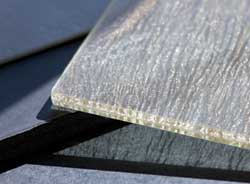The Art of Product Research and Selection
Tracking Data
With so much information to keep track of when researching new products, compiling data is the next task. Joe Crestuk, RA, of Crestuk Architecture, Fairport, New York organizes data with a products matrix, listing basic specifications sections and product details, including pros and cons. His evaluation criteria includes the context for product use, climate, location, number of facilities that have used the product successfully, product history, sustainability, durability, maintenance factors, value, recommendations by others, reports and tests. "Project budget usually plays an important role. Sometimes the building owner has input based on personal experience, preferences, or how they feel that day. Liability is an important factor during product selection. With so much litigation prevalent in society, no one wants to be the first one to use the product," Crestuk adds.
|
On the Internet, he typically begins with a search engine, enters a generic word and then specifics, such as product purpose and function. Seeking a commonly used product is easy, but if he is seeking something unique and different, the process is harder because there aren't many similar items for comparisons. "I'll call the source where I have seen the product before, and will usually spend as long as it takes to find it," says Crestuk, a comment echoed by most architects surveyed. Most Internet searches occur during the day, but if Crestuk gets a flash of inspiration at home, he may get on the web in the evening, email the links to the office and distribute internally.
The top position on a search engine results page does not necessarily show the best product, but often reflects a paid sponsorship. These ads may generate traffic to a manufacturer website, or at best, raise name brand recognition.
Saving, or "bookmarking" favorite product websites is a technique for quick access to frequently used manufacturers. But Crestuk and others wouldn't hesitate to change or bookmark a better or comparable product. Once information is found, the next step is often contacting the manufacturer or sales representatives for detailed information. "The information they have is often surprising because it covers more than the item I'm investigating," Crestuk observes.
Office Access to Product Information
Most architects take information gleaned from the Internet, print it and add to the project file, either a folder or binder, which is available to others in the office, and typically organized by CSI section. Emailing links is another way to share information with the office, client and consultant project team. Project managers must remain aware of what is available, and be able to share information as needed.
Presentations
Architects want product information that is easy to read, access, and use for presentations. PDF files suit this purpose, especially when images are stripped of text. Enlarged photos, mounted on boards are common techniques.
"We establish a rapport with manufacturers, and make demands on them. For presentations, we bring large material swatches, light fixture samples, and product boards, so clients can see and feel materials. Manufacturers comply with our requests 99 percent of the time, as they know we often specify products used in presentations. Clients like to display the presentation boards in their offices, showing material, finish, or lighting fixture samples with a model or rendering. With skyrocketing costs, we always consider alternatives to prevent labor and construction costs from impacting the final design," says Michael J. Mannetta, RA, Partner, Design Director, Spector Group, North Hills, New York.










